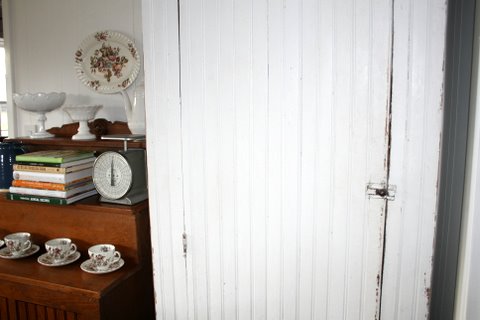Last year my parents moved across the country to retire on the 100 acres of beautiful farmland they purchased 5 years ago. The land is lush, rolling hills and has a hilltop with a spectacular view of the surrounding valley.
Before they could enjoy the leisurely life of being retired though (smile), a house needed to built, which meant living temporarily in a travel trailer on the top of their hill.
BEFORE:
Their travel trailer had everything they needed, but my mom, who had just left her home of 25 years, was having a hard time adjusting to her new boring, outdated living space. So she set about making the travel trailer a warm and cozy place to be by mixing vintage and Anthropologie finds.
Let me show you around!
THE KITCHEN
Pyrex and Fire King are just a few antique dishes that my mom has mixed with several finds from Anthropologie, like the measuring cups and measuring spoons hanging under the cabinet and a rolling pin in the corner. One of the most dramatic changes was removing the outdated curtains that came with the trailer and replacing them with feedsack fabric curtains.
THE CORNER CABINET
With space limited, the corner TV cupboard was turned into a place to store canned goods, tea bags, and coffee. Adhesive cork board was also placed on the back of the open cabinet to display photos of friends and family.
THE LIVING ROOM
The view from the hilltop is amazing and this chair with a handmade quilt draped over it is a perfect place to sit and drink coffee in the morning. A doorknob wind chime hangs in the corner.
The sofa was draped with a denim comforter and the curtains were replaced in this area of the trailer as well using the same feedsack fabric.
THE DINING AREA
The dining benches were recovered in denim and the table runner from Anthropologie coordinates perfectly with these bright vintage Massimo Vignelli Heller dishes. The spoon holder is actually meant for cookbooks (also from Anthro) but works perfectly for napkins in this small space.
THE BEDROOM
In the bedroom my mom wanted to create a space that would be slightly more masculine so my dad felt comfortable. She selected this plaid fabric for the curtains and lumbar pillow to create a cabin feel. The cardboard covered in fabric that used to pose as a headboard was removed and she simply hung a sweet wooden sign. The denim coverlet is from Target.
SOME OTHER FUN DECOR
Some other fun items in the travel trailer (clockwise) are antique swanky swig drinking glasses, a large lard tin canister used for a trash can, vintage tea towels, an orange enamelware coffeepot used for a utensil holder, and enamelware bowls and platters.
 |
| My sweet mom hugging my precious daughter |
I love the transformation from outdated pastels to what I call "vintage Anthropologie". My mom's style is a true reflection of her personality - warm, bright and cheerful.
I hope you enjoyed this fun tour!
I hope you enjoyed this fun tour!

























































